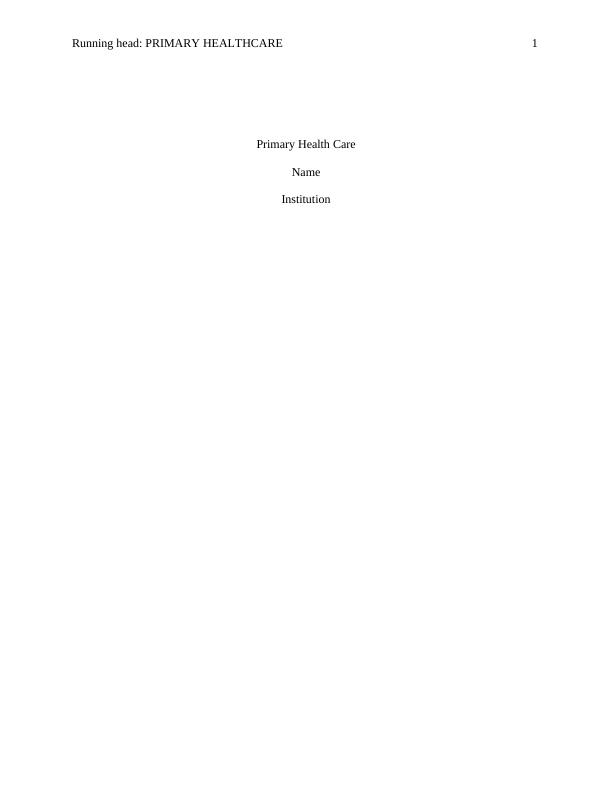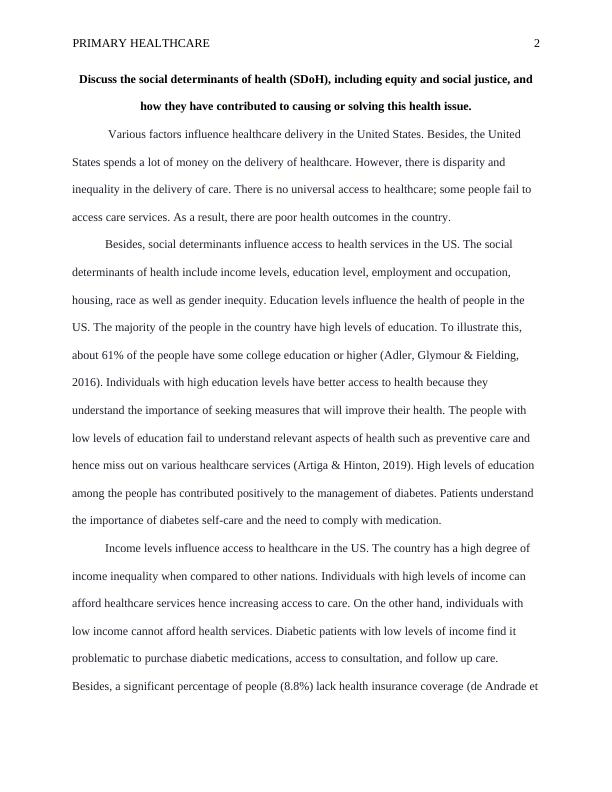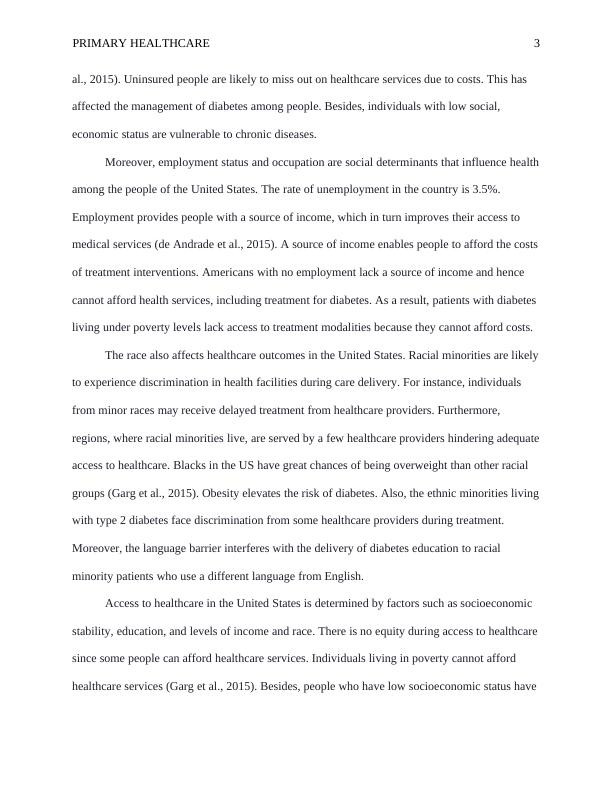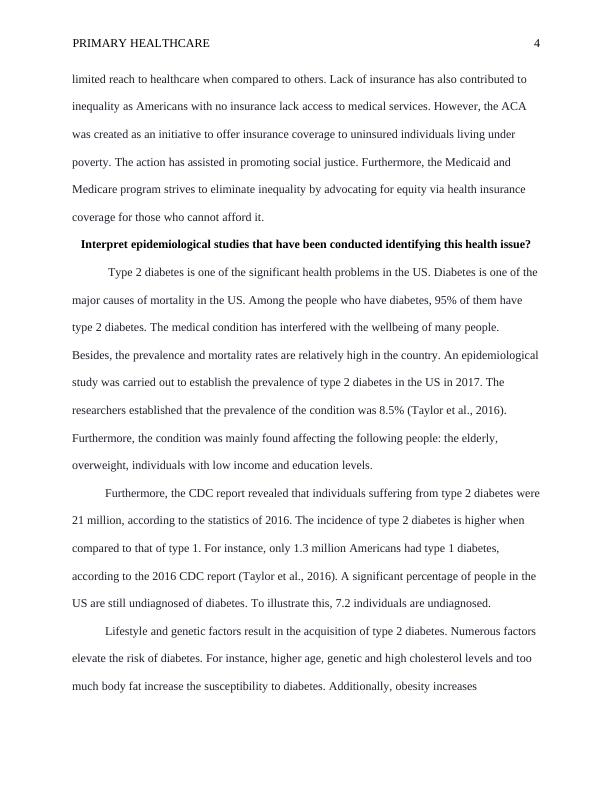Primary Health Care Question Answer 2022
Added on 2022-09-28
11 Pages3298 Words21 Views
Running head: PRIMARY HEALTHCARE 1
Primary Health Care
Name
Institution
Primary Health Care
Name
Institution

PRIMARY HEALTHCARE 2
Discuss the social determinants of health (SDoH), including equity and social justice, and
how they have contributed to causing or solving this health issue.
Various factors influence healthcare delivery in the United States. Besides, the United
States spends a lot of money on the delivery of healthcare. However, there is disparity and
inequality in the delivery of care. There is no universal access to healthcare; some people fail to
access care services. As a result, there are poor health outcomes in the country.
Besides, social determinants influence access to health services in the US. The social
determinants of health include income levels, education level, employment and occupation,
housing, race as well as gender inequity. Education levels influence the health of people in the
US. The majority of the people in the country have high levels of education. To illustrate this,
about 61% of the people have some college education or higher (Adler, Glymour & Fielding,
2016). Individuals with high education levels have better access to health because they
understand the importance of seeking measures that will improve their health. The people with
low levels of education fail to understand relevant aspects of health such as preventive care and
hence miss out on various healthcare services (Artiga & Hinton, 2019). High levels of education
among the people has contributed positively to the management of diabetes. Patients understand
the importance of diabetes self-care and the need to comply with medication.
Income levels influence access to healthcare in the US. The country has a high degree of
income inequality when compared to other nations. Individuals with high levels of income can
afford healthcare services hence increasing access to care. On the other hand, individuals with
low income cannot afford health services. Diabetic patients with low levels of income find it
problematic to purchase diabetic medications, access to consultation, and follow up care.
Besides, a significant percentage of people (8.8%) lack health insurance coverage (de Andrade et
Discuss the social determinants of health (SDoH), including equity and social justice, and
how they have contributed to causing or solving this health issue.
Various factors influence healthcare delivery in the United States. Besides, the United
States spends a lot of money on the delivery of healthcare. However, there is disparity and
inequality in the delivery of care. There is no universal access to healthcare; some people fail to
access care services. As a result, there are poor health outcomes in the country.
Besides, social determinants influence access to health services in the US. The social
determinants of health include income levels, education level, employment and occupation,
housing, race as well as gender inequity. Education levels influence the health of people in the
US. The majority of the people in the country have high levels of education. To illustrate this,
about 61% of the people have some college education or higher (Adler, Glymour & Fielding,
2016). Individuals with high education levels have better access to health because they
understand the importance of seeking measures that will improve their health. The people with
low levels of education fail to understand relevant aspects of health such as preventive care and
hence miss out on various healthcare services (Artiga & Hinton, 2019). High levels of education
among the people has contributed positively to the management of diabetes. Patients understand
the importance of diabetes self-care and the need to comply with medication.
Income levels influence access to healthcare in the US. The country has a high degree of
income inequality when compared to other nations. Individuals with high levels of income can
afford healthcare services hence increasing access to care. On the other hand, individuals with
low income cannot afford health services. Diabetic patients with low levels of income find it
problematic to purchase diabetic medications, access to consultation, and follow up care.
Besides, a significant percentage of people (8.8%) lack health insurance coverage (de Andrade et

PRIMARY HEALTHCARE 3
al., 2015). Uninsured people are likely to miss out on healthcare services due to costs. This has
affected the management of diabetes among people. Besides, individuals with low social,
economic status are vulnerable to chronic diseases.
Moreover, employment status and occupation are social determinants that influence health
among the people of the United States. The rate of unemployment in the country is 3.5%.
Employment provides people with a source of income, which in turn improves their access to
medical services (de Andrade et al., 2015). A source of income enables people to afford the costs
of treatment interventions. Americans with no employment lack a source of income and hence
cannot afford health services, including treatment for diabetes. As a result, patients with diabetes
living under poverty levels lack access to treatment modalities because they cannot afford costs.
The race also affects healthcare outcomes in the United States. Racial minorities are likely
to experience discrimination in health facilities during care delivery. For instance, individuals
from minor races may receive delayed treatment from healthcare providers. Furthermore,
regions, where racial minorities live, are served by a few healthcare providers hindering adequate
access to healthcare. Blacks in the US have great chances of being overweight than other racial
groups (Garg et al., 2015). Obesity elevates the risk of diabetes. Also, the ethnic minorities living
with type 2 diabetes face discrimination from some healthcare providers during treatment.
Moreover, the language barrier interferes with the delivery of diabetes education to racial
minority patients who use a different language from English.
Access to healthcare in the United States is determined by factors such as socioeconomic
stability, education, and levels of income and race. There is no equity during access to healthcare
since some people can afford healthcare services. Individuals living in poverty cannot afford
healthcare services (Garg et al., 2015). Besides, people who have low socioeconomic status have
al., 2015). Uninsured people are likely to miss out on healthcare services due to costs. This has
affected the management of diabetes among people. Besides, individuals with low social,
economic status are vulnerable to chronic diseases.
Moreover, employment status and occupation are social determinants that influence health
among the people of the United States. The rate of unemployment in the country is 3.5%.
Employment provides people with a source of income, which in turn improves their access to
medical services (de Andrade et al., 2015). A source of income enables people to afford the costs
of treatment interventions. Americans with no employment lack a source of income and hence
cannot afford health services, including treatment for diabetes. As a result, patients with diabetes
living under poverty levels lack access to treatment modalities because they cannot afford costs.
The race also affects healthcare outcomes in the United States. Racial minorities are likely
to experience discrimination in health facilities during care delivery. For instance, individuals
from minor races may receive delayed treatment from healthcare providers. Furthermore,
regions, where racial minorities live, are served by a few healthcare providers hindering adequate
access to healthcare. Blacks in the US have great chances of being overweight than other racial
groups (Garg et al., 2015). Obesity elevates the risk of diabetes. Also, the ethnic minorities living
with type 2 diabetes face discrimination from some healthcare providers during treatment.
Moreover, the language barrier interferes with the delivery of diabetes education to racial
minority patients who use a different language from English.
Access to healthcare in the United States is determined by factors such as socioeconomic
stability, education, and levels of income and race. There is no equity during access to healthcare
since some people can afford healthcare services. Individuals living in poverty cannot afford
healthcare services (Garg et al., 2015). Besides, people who have low socioeconomic status have

PRIMARY HEALTHCARE 4
limited reach to healthcare when compared to others. Lack of insurance has also contributed to
inequality as Americans with no insurance lack access to medical services. However, the ACA
was created as an initiative to offer insurance coverage to uninsured individuals living under
poverty. The action has assisted in promoting social justice. Furthermore, the Medicaid and
Medicare program strives to eliminate inequality by advocating for equity via health insurance
coverage for those who cannot afford it.
Interpret epidemiological studies that have been conducted identifying this health issue?
Type 2 diabetes is one of the significant health problems in the US. Diabetes is one of the
major causes of mortality in the US. Among the people who have diabetes, 95% of them have
type 2 diabetes. The medical condition has interfered with the wellbeing of many people.
Besides, the prevalence and mortality rates are relatively high in the country. An epidemiological
study was carried out to establish the prevalence of type 2 diabetes in the US in 2017. The
researchers established that the prevalence of the condition was 8.5% (Taylor et al., 2016).
Furthermore, the condition was mainly found affecting the following people: the elderly,
overweight, individuals with low income and education levels.
Furthermore, the CDC report revealed that individuals suffering from type 2 diabetes were
21 million, according to the statistics of 2016. The incidence of type 2 diabetes is higher when
compared to that of type 1. For instance, only 1.3 million Americans had type 1 diabetes,
according to the 2016 CDC report (Taylor et al., 2016). A significant percentage of people in the
US are still undiagnosed of diabetes. To illustrate this, 7.2 individuals are undiagnosed.
Lifestyle and genetic factors result in the acquisition of type 2 diabetes. Numerous factors
elevate the risk of diabetes. For instance, higher age, genetic and high cholesterol levels and too
much body fat increase the susceptibility to diabetes. Additionally, obesity increases
limited reach to healthcare when compared to others. Lack of insurance has also contributed to
inequality as Americans with no insurance lack access to medical services. However, the ACA
was created as an initiative to offer insurance coverage to uninsured individuals living under
poverty. The action has assisted in promoting social justice. Furthermore, the Medicaid and
Medicare program strives to eliminate inequality by advocating for equity via health insurance
coverage for those who cannot afford it.
Interpret epidemiological studies that have been conducted identifying this health issue?
Type 2 diabetes is one of the significant health problems in the US. Diabetes is one of the
major causes of mortality in the US. Among the people who have diabetes, 95% of them have
type 2 diabetes. The medical condition has interfered with the wellbeing of many people.
Besides, the prevalence and mortality rates are relatively high in the country. An epidemiological
study was carried out to establish the prevalence of type 2 diabetes in the US in 2017. The
researchers established that the prevalence of the condition was 8.5% (Taylor et al., 2016).
Furthermore, the condition was mainly found affecting the following people: the elderly,
overweight, individuals with low income and education levels.
Furthermore, the CDC report revealed that individuals suffering from type 2 diabetes were
21 million, according to the statistics of 2016. The incidence of type 2 diabetes is higher when
compared to that of type 1. For instance, only 1.3 million Americans had type 1 diabetes,
according to the 2016 CDC report (Taylor et al., 2016). A significant percentage of people in the
US are still undiagnosed of diabetes. To illustrate this, 7.2 individuals are undiagnosed.
Lifestyle and genetic factors result in the acquisition of type 2 diabetes. Numerous factors
elevate the risk of diabetes. For instance, higher age, genetic and high cholesterol levels and too
much body fat increase the susceptibility to diabetes. Additionally, obesity increases

End of preview
Want to access all the pages? Upload your documents or become a member.
Related Documents
Health Inequalitylg...
|9
|2185
|352
Assignment on Poverty - Population Overviewlg...
|4
|636
|28
Socioeconomic Status and Gender Differences Influence on Health Inequalitieslg...
|4
|814
|35
Closing The Gap (CTG) Policy and its Significance to Indigenous Australianslg...
|9
|2346
|488
Population Health Care Nursinglg...
|4
|826
|260
Social Determinants of Health among Diabetic Patientslg...
|8
|1587
|187
